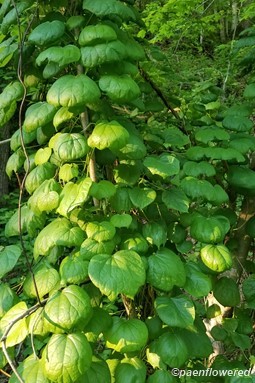Menispermum canadense
Menispermum canadense Canadian moonseed
Canadian moonseed is a decidious, twining (no tendrils) woody vine growing up to 20 feet tall. Small dioecious clusters of greenish-white flowers are borne in the leaf axils. Flowers are 3-merous with all flower parts distinct. Each female flower in a cluster ripens into a berry-like drupe. These one-seeded blue-black berries look very much like wild grapes and are highly toxic. Ingestion may cause death by inducing a very rapid pulse and severe vomiting.
Habitat & Range
Frequent along moist shores, woods edges, moist woods & floodplains. Prefers rich, moist soils and light shade.
Present throughout the state.
Range: Native to North America from Manitoba to Quebec and through eastern US south to Georgia and west to Oklahoma.
| EMP: | FACU |
|---|---|
| NCNE: | FAC |
Phenology
Flowers in June.
Fruits September & October.
Characteristics
Flowers dioecious, whitish-green, in small axillary panicles; 6 to 9 petals and sepals, sepals longer than petals; ¼ inch across
Staminate flowers 12 to 24 white stamens with yellow tips
Pistillate flowers 2 or 3 pistils; 6-12 sterile stamens
Leaves alternate, simple; almost orbicular, entire to slightly lobed; on long, slender stalks; peltate near margin; palmately veined; 4-6 inches wide
Fruit blue-black one-seeded berries; ⅓ inch; seed flattened, crescent-shaped with a rough surface
Root yellow, long and round in cross-section
Height 12-20 feet
Plant Codes
S-rank: No Rank
G-rank: G5 (Secure)
Medicinal Qualities
This plant contains berberine and similar alkaloids that have long been used in treatment of chronic ailments. A tea made from root can be used as a tonic, diuretic and laxative.

.JPG?v=638875805160000000)


Comments
Have you spotted this plant in your area? We'd love to hear about your experience! Share your comments or questions about the plant below. Comments are moderated before posting.